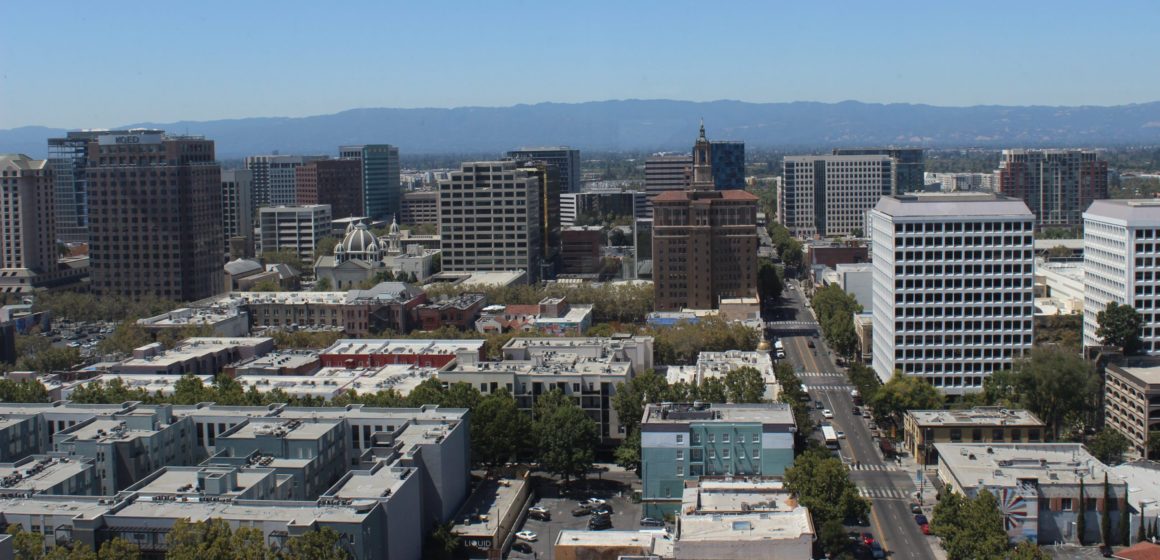Recent tech layoffs likely won’t prevent downtown San Jose from becoming a thriving commercial and residential hub. But uncertainty around remote work culture and lengthy timelines for completing major transit and development projects could spell years more struggle for the area and its businesses.
Three regional experts said while tech company layoffs have captured big headlines, their cumulative impact will not be catastrophic. Silicon Valley’s overall economy remains strong, and downtown San Jose is poised to succeed.
“For the longer term I have a very positive outlook,” Alex Stettinski, CEO of the San Jose Downtown Association, told San José Spotlight. “I think downtown San Jose will morph and shift and change, but I think it will become more vibrant than it has ever been before.”
The area’s saving grace, experts said, will be the buildout of long-anticipated projects, including thousands of homes, Google’s 80-acre mega campus and significant transit upgrades. But some of those catalyst projects, like BART to downtown, could take a decade to be complete.
More companies and workers returning to offices would also be a big boost to the area, they said, but it’s unclear how soon that will happen.
Meanwhile, downtown San Jose could continue to flounder for years to come as storefronts and offices remain vacant, in addition to the challenges shops and eateries face with reduced foot traffic.
Stettinski said in talking with companies, workers and investors, he’s optimistic major commercial developments will begin to fill up, and thousands of new homes will bring people back to the area.
“The work culture will probably morph into some kind of a hybrid. I don’t know that it will ever go back to what it used to be: five days a week and eight hours a day in the office,” he said. “It’s still all in transition.”
While the continuing march of tech layoffs has raised alarms around the region, Russell Hancock, CEO of think-tank Joint Venture Silicon Valley, said the numbers need to be kept in context.
Tracking site Layoffs.fyi said more than 1,000 tech companies worldwide have announced more than 170,000 layoffs across 2022 and the early part of this year.
But Hancock said only about 9,000 of those have been Silicon Valley workers so far.
That includes about 2,700 Meta workers in Silicon Valley, according to employer records filed with the state. Twitter, which eliminated thousands of jobs in rounds of layoffs, cut roughly 100 workers in San Jose. San Jose based-company Cisco announced last year it would eliminate thousands of jobs, and has cut more than 600 jobs locally so far. Meanwhile, San Jose-based PayPal has laid off 59 people in the city, while Roku has laid off nearly 100. San Jose-based Western Digital is laying off nearly 200 people across its San Jose and Milpitas offices.
“That’s a big deal, but we also have to remind people that our workforce in Silicon Valley is 1.5 million. So we’re still talking about a very small percentage of the workforce being affected,” Hancock told San José Spotlight.
Too much, too fast
Hancock said tech companies scaled up hiring during the first two years of the COVID-19 pandemic with a boom in demand for streaming, conferencing and communication platforms, as well as food and goods delivery services. The current layoffs reflect a downward adjustment, not a crisis, Hancock said.
Alexander Quinn, JLL senior director for research in Northern California, agrees, noting several large Bay Area tech companies still have higher head counts after their announced layoffs than they had before the pandemic hiring sprees.
Hancock said the choices of major employers and their employees around returning to the office will have a big impact on downtowns, including San Jose. Workers choosing to stay home is decimating downtowns, Hancock said.
“They are no longer the lunch scene and they are no longer that hub of activity. That is a long-term issue and it probably means painful adjustments for small businesses and other downtown establishments,” he said.
Quinn said companies may choose to reduce their office investments to save cash, but in his view, the value of office space will endure. Employers are recognizing the utility of an in-person work environment.
“Collaboration is hugely important to the operation of (their) business,” Quinn told San José Spotlight.
Both Hancock and Quinn said Silicon Valley will likely continue to be a world leader in technology innovation and enterprise. In the short term, there are office projects coming online that don’t yet have long-term leases or major companies attached to them, Quinn said.
But with Google’s Downtown West project still on track to create millions of square feet of office space as a good starting point, Quinn said other major planned office and housing investments are betting on downtown’s long-term success as a major commercial business district.
He also said BART’s downtown San Jose extension and increased train frequency through Caltrain after electrification will offer a bigger labor pool for employers who want to have a downtown presence.
“There is a lot of inventory coming on the market, with the expectation that there will be a tech migration from western Silicon Valley into downtown San Jose,” he said.
But until and unless all of these bets materialize, the experts said, there could still be short-term struggles downtown.
“I do think in the long term it will happen,” Stettinsky said. “The only question now is, how long is that transition period going to be?”
Contact Joseph Geha at [email protected] or @josephgeha16 on Twitter.



Leave a Reply
You must be logged in to post a comment.